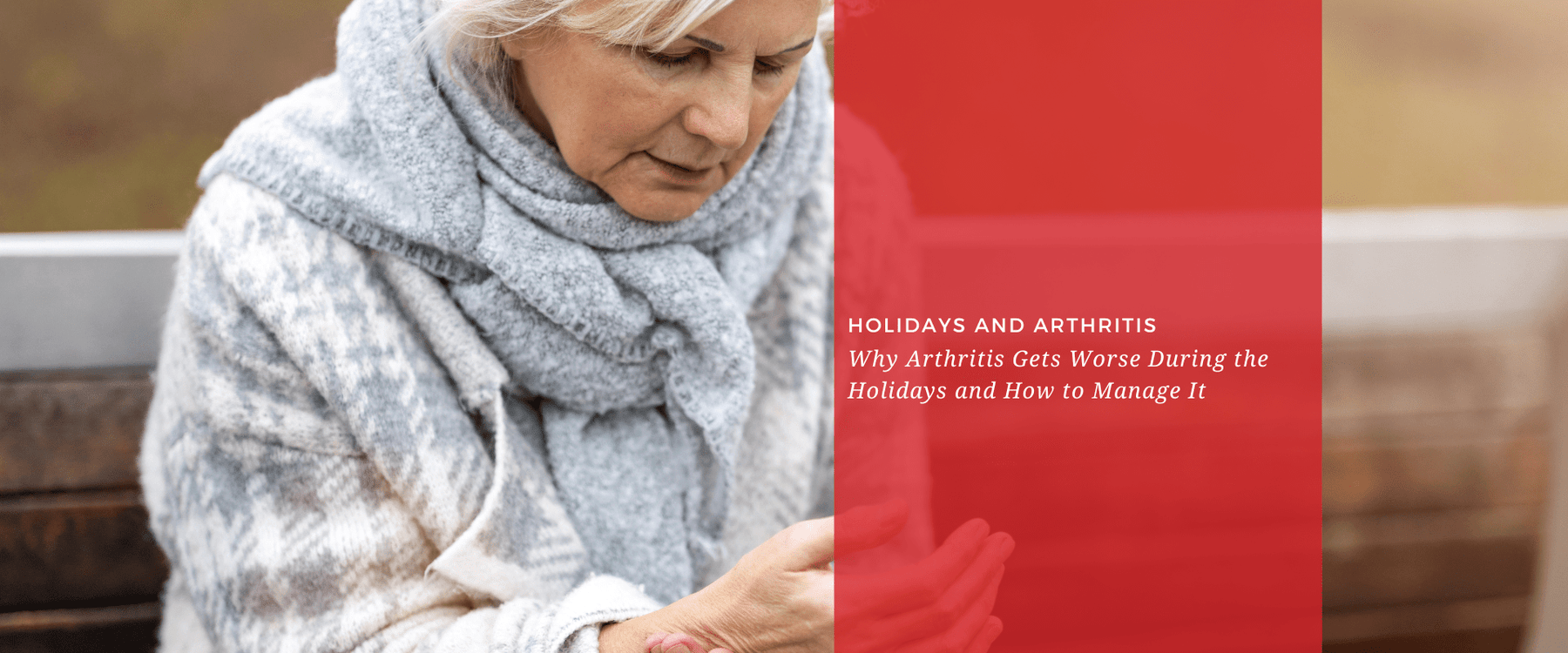With over 1 million orders

Holidays and Arthritis: Why It Gets Worse and How to Manage It
The holiday season is a time for joy, family, and celebration, but holidays and arthritis aren't the best match. Whether you have rheumatoid arthritis (RA) or osteoarthritis (OA)—it can also be a season of increased pain and discomfort.
The holiday season often coincides with winter, bringing colder temperatures that can wreak havoc on arthritic joints. When it is cold outside, nerves and blood vessels constrict in the arms and legs, decreasing blood flow and circulation to keep our inner core (heart and organs) warmer. This causes our joints to become more stiff and painful. A drop in barometric pressure may also lead to increased joint pain for some.
Layering on top of this, the festive season often involves long periods of sitting, standing, or repetitive motions like wrapping gifts or cooking meals—all of which can exacerbate the effects of reduced circulation. And since the holidays are a busy time, many people naturally exercise less, leading to a loss of muscle strength and flexibility, further compounding joint discomfort.
“When it’s cold outside, nerves and blood vessels constrict to preserve core warmth, reducing circulation to joints and making them stiff and painful. Combined with lower activity levels during the holidays, this can lead to increased joint discomfort,” explains Dr. Akash Kansagra, who heads the Dr. Arthritis Medical Team.
Between the stress, cold weather, and changes in routine, it’s no surprise that symptoms like joint pain, stiffness, and fatigue often feel worse. Let’s break down why this happens and, more importantly, what you can do to make the holidays more manageable.
Holidays and Arthritis Lead to Worsening Symptoms
1. Stress Levels Skyrocket

The holidays are notorious for ramping up stress levels. Whether it’s shopping for gifts, hosting family gatherings, or traveling long distances, these added pressures can take a toll. For those with arthritis, stress can trigger inflammation in the body, leading to heightened pain and stiffness in the joints.
2. Cold Weather Isn’t Kind
If the holidays coincide with colder temperatures, you might notice your symptoms worsening. Many people with arthritis find that the drop in temperature leads to stiff, achy joints. The cold reduces circulation, which can aggravate already inflamed joints.
3. Overexertion and Physical Strain
Holiday tasks like decorating, standing for hours while cooking, or lifting heavy shopping bags can be taxing on your joints. Overexertion often leads to inflammation and swelling, especially in joints that are already compromised.
4. Changes in Routine and Diet
It’s easy to overindulge during the holidays—rich foods, sugary desserts, and festive cocktails are everywhere. These indulgences, coupled with a disruption in your regular exercise or medication routine, can worsen inflammation and throw your body off balance.
5. Emotional Toll
Holidays aren’t always merry and bright. For some, they bring up emotional stressors like family tension or loneliness. These feelings can further impact arthritis symptoms, as emotional stress has been linked to physical flare-ups.
What You Can Do to Reduce Holiday Arthritis Symptoms
1. Plan Ahead
Tackle holiday preparations in bite-sized chunks to avoid overexertion. Write a to-do list, prioritize what’s most important, and don’t hesitate to delegate tasks to family or friends.
Schedule Tasks by Energy Levels: Break your day into high-energy and low-energy periods, assigning physically demanding tasks to when you feel your best and reserving simpler tasks for later.
Prep in Advance: Complete time-consuming tasks like gift wrapping, meal prep, or decorating on quieter days to avoid last-minute scrambling.
Use Time-Saving Tools: Opt for delivery services, pre-chopped groceries, or ready-made holiday decorations to cut down on unnecessary strain.
2. Stay Warm
Combat cold-weather stiffness by layering up with warm clothing and using heat-based remedies. Heated blankets, hand warmers, and even warm baths can do wonders for stiff joints. If you’re spending time outdoors, make sure to bundle up to protect your joints from the chill.
Wear Thermal Accessories: Use thermal gloves, socks, and joint sleeves designed to retain heat and provide extra support during cold weather.
Create a Warming Routine: Start your day with a warm shower or bath to loosen stiff joints, and keep heat packs or heating pads handy for quick relief throughout the day.
Optimize Your Home Environment: Maintain a comfortable indoor temperature with space heaters, and use draft stoppers to keep cold air from creeping in.
3. Stick to Your Routine
It’s easy to let your routine slip during the holidays, but keeping up with your medication, physical therapy exercises, and regular stretches is essential. Even on busy days, try to carve out time for gentle activities like yoga or a short walk to keep your joints moving.
Set Alarms or Reminders: Use your phone or a planner to schedule medication times, stretches, and therapy exercises to ensure they don’t get lost in the holiday rush.
Incorporate Movement into Activities: Take a quick walk after a big meal or stretch while watching holiday movies to sneak in some joint-friendly activity.
Pack a Travel Kit: If you’re traveling, bring along essential items like medications, resistance bands, or a printed list of your physical therapy exercises to stay consistent on the go.
4. Be Mindful of Your Diet
While it’s fine to indulge a little, try to focus on foods that are anti-inflammatory, such as leafy greens, salmon, and nuts. Limit alcohol and sugar where possible, and make sure you’re staying hydrated throughout the day to support your joints.
Fill Half Your Plate with Vegetables: At meals, prioritize nutrient-rich, anti-inflammatory options like roasted Brussels sprouts, sweet potatoes, or a fresh salad.
Swap Sweets for Healthier Treats: Satisfy your sweet tooth with dark chocolate or fruit-based desserts, which are less likely to trigger inflammation than sugary alternatives.
Drink Smart: Choose herbal teas or infused water over sugary drinks, and if you’re drinking alcohol, alternate with water to stay hydrated and reduce inflammation risk.
5. Practice Stress Management
Take breaks when you need them and incorporate relaxation techniques like deep breathing, meditation, or even just sitting quietly with a cup of tea. Remember, it’s okay to step away from the chaos and recharge.
Schedule Quiet Time: Block out 10–15 minutes each day to sit in a calm space, practice deep breathing, or simply enjoy a moment of silence to reset your mind.
Try Guided Relaxation Tools: Use apps or videos for quick guided meditations or mindfulness exercises tailored to reducing stress and calming the body.
Set Realistic Expectations: Avoid overcommitting by prioritizing what truly matters to you and gently declining activities that feel overwhelming or unnecessary.
6. Use Adaptive Tools
Make your life easier with arthritis-friendly gadgets. Tools like jar openers, ergonomic kitchen utensils, and lightweight pots and pans can reduce strain on your joints. Compression gloves can also provide support and warmth while you tackle tasks.
Invest in Kitchen Helpers: Use gadgets like electric can openers, silicone jar grips, or lightweight cutting boards to make food prep less taxing on your hands and wrists.
Opt for Ergonomic Household Items: Look for arthritis-friendly tools like pens with cushioned grips, scissors with spring-assisted handles, or gardening tools with extended grips.
Wear Supportive Accessories: Use compression gloves or wrist braces during activities like cooking or wrapping presents to reduce joint strain and improve grip.
7. Know When to Say No
Your health comes first. If an event or task feels like it will be too much for you, it’s okay to say no. Setting boundaries can help you avoid unnecessary stress and overexertion.
Prioritize What Matters Most: Focus on the events and traditions that bring you joy, and let go of those that feel more like obligations.
Practice Polite Declines: Have a kind but firm response ready, such as, “I’d love to help, but I need to take care of my health right now.”
Set Limits in Advance: Communicate your boundaries early, like only staying at gatherings for a set amount of time or skipping physically demanding activities.
Expert Coping Tips for Holidays and Arthritis
Schedule Recovery Time: Build rest days into your holiday plans to give your body a chance to recover after busy events.
Communicate Your Needs: Let loved ones know how they can support you—whether it’s helping with tasks or adjusting plans to accommodate your needs.
Consider Supplements or Topicals: Some people find relief with natural remedies like turmeric supplements or topical treatments such as capsaicin creams.
Managing The Stress of The Holidays
The holidays bring unique challenges for those with arthritis, as colder weather, stress, and busy schedules can amplify joint pain and stiffness. However, you don’t have to let arthritis hold you back from enjoying the season. Thoughtful planning, staying warm, and using supportive tools like the Dr. Arthritis range of products can make a big difference. Designed by medical doctors, their compression gloves, braces, and supports provide targeted relief and help you stay active and comfortable throughout the holidays. Prioritizing your health and making small adjustments can turn a season of struggle into one of celebration.


